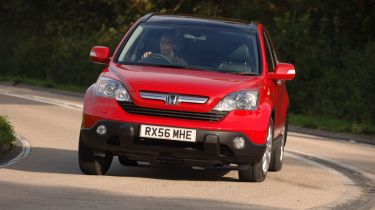Honda CR-V i-CTDi EX
Honda's CR-V's fast and economical, but the firm ride makes it uncomfortable on long trips
It’s difficult to believe, yet Honda has as much experience in this sector as Land Rover. The first CR-V was launched here in 1997, but as Japanese model cycles are much shorter than their European counterparts’, the firm has already pulled the wraps off its third-generation recreational off-roader.
And it’s a real change from the previous one. The most obvious alteration is the rounder roofline, which dips to form the D-pillar. It’s curvy and bold, giving added impact, but we’re less convinced by the odd tailgate and fiddly nose treatment. Nevertheless, with the CR-V and Civic, it’s clear Honda is serious about taking a bolder design direction – good news for those who value individuality.
But what about practicality? On the surface, the fact the new car is 100mm shorter, 30mm lower and has a smaller wheelbase than its predecessor appears to be bad news. Yet most of the lost length is down to the spare wheel being under the boot floor rather than on the tailgate, while the roofline has helped lower the centre of gravity by 35mm, boosting stability and handling.
And the smaller dimensions do not mean the cabin is cramped. True, it’s not nearly as spacious as the Hyundai, but the CR-V can carry five people comfortably due to the flat floor and 60:40-split rear seats that slide over a 150mm range. The 556-litre boot now has a top-hinged tailgate, too.
Used - available now

2023 Land Rover
Range Rover Evoque
21,916 milesAutomaticPetrol1.5L
Cash £28,500
2021 Tesla
Model 3
30,193 milesAutomaticElectric
Cash £18,800
2023 Tesla
Model 3
55,994 milesAutomaticElectric
Cash £18,000
2023 Mercedes
CLA
36,008 milesAutomaticDiesel2.0L
Cash £21,200Yet despite the improvements, the Honda is still not as family-friendly as we would like it to be. Headroom is modest and, rather than getting a clever seat-folding mechanism such as in the Accord Tourer, the rear chairs simply tumble forward, limiting overall load length.
At least everything in the CR-V’s cabin works with real precision. Not even the Land Rover feels as well built as the Honda – and nor does it have such an accommodating driving position. On top of that, the seats are large and well shaped, and the interior design is far more enticing than before. But we’re not keen on the warning beeps that echo around the cabin when you turn the ignition on. They’re irritating and take a bit of getting used to.
The acclaimed four-cylinder i-CTDi diesel is a peach, though. Although not the best in terms of smoothness and noise insulation (that honour goes to the Santa Fe’s motor), it delivers easily the best performance. It picks up strongly from below 1,500rpm, and provides the best in-gear pace. While the Honda weighs in at 1,729kg, the engine’s sheer muscle would make you think it’s far lighter.
That’s not to say it feels flimsy, though – quite the opposite. In fact, the new CR-V is 85 per cent stiffer than its predecessor. There’s no hint of chassis flex or shake in corners (unlike in the Hyundai and Nissan), and as a result of this, plus the wider track and revised suspension, it’s extremely agile and responsive to drive. Honda has fulfilled its aim of making the CR-V feel more like a family car – for the most part, at least.
While it corners flatly, inspires confidence, is rattle-free and has a tight, positive six-speed manual gearchange, the sporty suspension and road noise mean the car isn’t the best choice for long trips or bumpy roads. In short, the ride is too firm.
Nevertheless, that’s unlikely to stop Honda achieving its target of 22,000 UK sales next year – especially considering the CR-V’s excellent safety credentials and generous equipment. Compared to the Freelander, it looks good value for money, too.
Details
Price: £25,000 (est)
Model tested: Honda CR-V i-CTDi EX
Chart position: 3
WHY: The CR-V was partly engineered in the UK and is built at Honda’s plant in Swindon, Wilts. On sale from January, the CR-V is lower, wider and stiffer than before. There are six models, using a 2.0-litre petrol or the acclaimed 2.2-litre diesel.
Economy
The CR-V is the fastest and the most economical, too, thanks to its amazing i-CTDi engine. We achieved 36.4mpg in mixed conditions, but 40mpg is easily possible and a 464-mile range is good.
Residuals
As with the Land Rover, the CR-V’s residual values have yet to be finalised, but the new version should fare better than the 49 per cent of the previous model. Expect the diesel to retain around 53 per cent.
Servicing
Honda finished second in our Driver Power dealer survey this year, and that should ensure great peace of mind for CR-V owners. Costs aren’t yet available, but shouldn’t change much from the previous model.
Tax
Having the cleanest engine helps the CR-V hugely. Although it’s more expensive than the Hyundai or Nissan, it will be cheaper for business users, sitting at least four tax brackets below its opponents.







